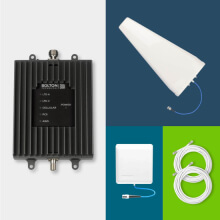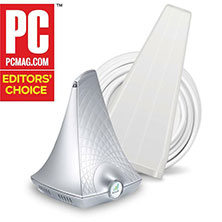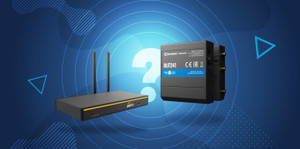Building Materials That Kill Your Cell Reception
Have you ever noticed that you may have full 5G or 4G bars outside, but the minute you walk into a building you have bad cell signal? Even in a city with 5G and 4G towers all around you, cell signals can have a hard time getting through walls. The new high rise that goes up next to your office could be the reason for your suddenly terrible cell service.
The same goes for your house. What if you buy a house with a shingle roof that gets great reception, but once you have upgraded to a metal roof you suddenly have bad cell service? That roof makes a difference. If you are in the mountains and get a cell phone signal around this curve, but not that one, trees or a hill may be blocking the signal as well. All sorts of things block cell signal, from building materials to trees, weather, and even glass.
Take advantage of our system design and installation services. Learn more or call us for a free consultation: 1-800-969-8189.
How Do You Measure Cell Signal?
Cell signals are measured in dBm or decibel milliwatts. This measurement is true for all carriers and all frequencies. Cell phone signals run at frequencies between -50 dBm and -120 dBm. The lower end of the spectrum at -50 dBm is equivalent to 4 bars on your cell phone. -120 dBm is a dead zone. Outside signal of -60 dBm is pretty good.
Measuring your cell signal in bars is not accurate. Bars are subjective. Different carriers and different phones show different bar readings as they choose. Verizon may show 2 bars of signal, while T-Mobile may show three, and both could be completely different depending on whether you have an Android or an iPhone. Meanwhile, your dBm reading is the same. dBm readings are exact.
dBm increases in strength logarithmically. Every 3 dBm up or down means gaining or losing double the power. Building material and other obstructions will subtract from your overall dBm, potentially leaving you with a dead zone.
Why Does My 5G Suck?
There are three types of 5G coverage: low-band, mid-band (or C-band), and millimeter-wave.
Mid-band and millimeter-wave 5G operates at a higher frequency than 4G. It carries more data faster, but cannot reach as far. High-band 5G is interrupted even easier than 4G signal. Every material that blocks 4G will be even worse for 5G.
However, low-band 5G generally operates around the same frequencies as 4G, and should have about the same coverage. If 5G sucks in your area, it’s probable your carriers have yet to build it out properly. That, or material in your building is disrupting the signal.
What Blocks Cell Phone Signals?
Bad Cell phone signals can be blocked a little or a lot depending on the type of materials used in construction of the building. Materials that do not conduct electricity like wood, drywall, plastics, and glass will impede a cellular signal, but not block it. Materials such as tin, copper, silver, aluminum and others can completely block the signal. Let’s investigate some of these materials that block cell phone signals.
Materials that do not conduct electricity like wood, drywall, plastics, and glass will impede a cellular signal, but not block it. Materials such as tin, copper, silver, aluminum, and others can completely block the signal.
What your building is made of can play a large part in how bad your service is inside, but where your building is situated is also important. Learning how to boost cell signals in the woods can negate some of the effects of cell-blocking building materials.
Most homes and small offices are made of wood, plywood, fiberglass insulation, and glass. Big brick or metal buildings can block signal even more so than smaller wooden ones. Add all these materials together in a building and you could have a good answer to why there is no cell service inside.
Insulation and Drywall (-2 dB to –4 dB)
Most houses’ interior walls are made from layers of drywall packed with fiberglass insulation. The more layers of building materials, the more signal is blocked. Fiberglass is quite porous at -2dB but add drywall and the loss is -4 dB.
Plywood (-4 to -6 dB)
Plywood is a commonly used building material in homes and internal office walls. It's light, easy to use, and loves to soak up cell signal like a sponge. The thicker the plywood used the more it blocks signal. If it's wet, you can expect a drop in signal up to –20 dB, so make sure it stays dry!
Solid Wood (-5 to -12 dB)
Solid wood is beautiful but can have a significant effect on cell signal. Walls, ceiling beams, and even furniture can drop signal by –5 to –12 dB.
Glass (-4 to -40 dB)
You might think signals can pass through glass, but clear glass refracts the signal, causing a loss of about -4dB. If you have tinted glass designed for energy efficiency and privacy (low-E glass), this rate of loss is a staggering -24 dB to -40 dB.
Plaster (-8 to -16 dB)
Walls are usually covered with plaster to insulate them and make them look good. Plaster itself blocks cell signals by up to –16 dB, depending on how thick it has been plastered on. Try to keep your plastering to a minimum for better cell service inside.
Concrete and Cement (-10 to -20 dB)
If you want a room that blocks cell phone signal, create it out of cement or concrete. Between -10 dB and -20 dB is the average loss. Ever noticed how you can have great signal outside but almost nothing in the middle of a parking structure, even if it has open sides? That’s because the concrete blocks more signal the deeper in you go.
Brick (-8 to -28 dB)
Classic homes and old buildings with a lot of character are often built of brick. Expect a loss of between -8 dB to -28 dB.
Metal (-32 to -50 dB)
Metal is the number one villain when it comes to blocking cell signal. This is why there is never signal in an elevator. You can lose between -32 dB and -50 dB of signal when trying to penetrate a metal barrier.
Outside (-3 to -20 dB)
It's not just building materials that block cell signals and give you bad reception. Trees, mountains even the weather like fog can affect cell signal. Rain can cause between -3 to -5 dB loss and foliage between -7 to -20 dB.
These numbers are for 4G LTE, 5G will have an even harder time penetrating building materials and outside obstructions.
How Do I Get Better Cell Signal?
You found the perfect house or location for your business and the building is made of brick or cement. Do you choose another site? No! First, check the cell phone signal inside. These loss rates are guidelines and whether your signal is degraded or completely lost indoors, is quite variable. Depending on your internet needs, you might be just fine.
If you are in an office building, there are requirements for construction that require emergency systems and services to be able to work everywhere. Your building manager has probably installed boosters and amplifiers for great signal. Check this before signing a lease agreement for office space.
Get Better Cell Reception With A Signal Booster
If your signal is inadequate at home, you can add a cell phone signal booster! A cell phone signal booster is a great way to get good cell reception inside. If you have a great signal right outside the door, install an antenna ffacing in the direction of the strongest cell phone tower. Run the cable inside and the signal booster can project that signal through the building. A Wi-Fi extender can get it to impossible-to-reach places. This way you have privacy and can still manage your devices or network indoors.
The point is, no matter what materials were used in the construction of a home or office building, there are ways to get the service you need or want. (And now you also know how to use materials to block a cell phone signal as well for privacy in your Zen meditation room.) Just be aware of the effects of choices and explore solutions.
Try one of these to combat bad signal at home or at the office:
Our Top Recommendations:
Best Home Signal Booster Kits
Bolton Victory Yagi/Panel Cellular Signal Booster
Overview of the Bolton Victory Yagi/Panel:
- For Small to Medium Size Homes and Offices
- Covers Up to 4,000 Sq Ft
- Up to +72 dB Gain
- Up to 26 dBm Uplink Power
- Supports All Carriers Simultaneously
The Bolton Victory Yagi/Panel cellular booster is our top pick for rural areas. Under optimal conditions, it can blanket up to 4,000 sq ft with stronger cell reception, which is more than enough for most people. Featuring up to 26 dBm uplink and up to 72 dB gain, it has incredible reach and can significantly amplify your existing weak cellular signal.
Strategically paired with the Bolton Quicksilver Outdoor Yagi Antenna, it works wonders in remote locations. This antenna is designed to draw in signals from cell towers up to 5 miles away. Distance from the signal source will no longer be a problem.
While capable of boosting multiple carriers at the same time, you may only receive improved cell reception from one or two carriers. This is because the antenna is directional and needs to point at the closest cell tower that’s powered by your preferred carrier. If boosting multiple carriers is more important than coverage area, consider the Bolton Velocity Omni/Panel Cellular Signal Booster.
| Pros: | Cons: |
|
|
SureCall Flare 3.0
Overview of SureCall Flare 3.0:
- For Small Homes or Spot Coverage
- Covers Up to 3,000 Sq Ft
- Up to +72 dB Gain
- Up to 26 dBm Uplink
- Supports All Carriers Simultaneously
- 2-in-1 Amplifier/Indoor Antenna Combo for Ease of Installation
The SureCall Flare 3.0 cellular booster packs a signal punch for the price. It includes a Yagi antenna, which is ideal for rural areas, and a sleek amplifier. The indoor antenna is built into the amplifier, making the Flare 3.0 one of the easiest units to install yourself.
With up to 72 dB gain and 26 dBm uplink, it offers good amplification and reach to distant cell towers for a booster of its kind. While power is similar to that of the Bolton Victory, the Flare 3.0 offers less coverage and a less powerful Yagi antenna. It’s rated to cover 3,000 sq ft, but will likely only provide multi-room to spot coverage.
| Pros: | Cons: |
|
|
The point is, no matter what materials were used in the construction of a home or office building, there are ways to get the service you need or want. (And now you also know how to use materials to block a cell phone signal as well for privacy in your Zen meditation room.) Just be aware of the effects of choices and explore solutions.
Contact Us
We’re here to assist with any issues you might be experiencing with poor cell service. Contact us today, or call us at 1-800-470-6777.
Interested in Learning More? Check Out Our Cellular Info Hub / WiFi Info Hub







